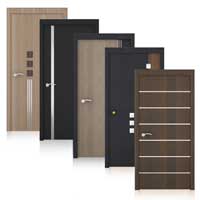Flush Doors: Users' Experience, feedback and reviews |
| | Flush Doors |  |
|
|
|
| User Experience |
Read User Experience, Comment, Feedback here and share your own thoughts about Flush Doors.
Regards.
GharExpert Support Team |
|
|
|
|
| Raw Material | Flush doors is a name given to doors that are made by using a timber frame which is covered by plywood or MDF or similar board on both the sides of the door. The hollow portion inside the door is usually filled with cardboard or board. These doors are then finished by putting veneer on top or teak ply on top to give it a finishing. These doors have a perfectly flush and joint less surface. |
| Accessories required to implement | Flush doors are very easy to install using minimum efforts and the Accessories required to implement. Raw materials required for their installation are: - Door Handles
- Door Viewers
- Door closers
- Door Bells
- Door Frames
- Door Stoppers
- Architrave
- Hinges and screws.
- Tower bolt.
- Mortise lock.
- Sliding bolt
|
| Maintenance | | Flush doors have a shutter which is plain in appearance so these doors are easy to maintain as the plain surface does not gather dust. The doors either have veneer skin which is finished using polish or the doors are painted with paint which makes the maintenance easier and all you need to do is wipe clean the doors with dry cloth. In case there is a termite problem in your area, it is recommended to buy termite resistance wood and board for these doors |
| How is it manufactured | | Flush door shutters are manufactured in the factory from the raw materials Formed by gluing by the hot press process on both faces of core either ply wood or cross bands and face veneers in the required thickness and size as per ISNo2201-1999. |
| Advantages | - Simple design and are less expensive.
- Come in attractive colors and have rich and warm appearance.
- More durable.
- Can’t split, peel or rot, and don’t require periodic refinishing.
- Resistant to stains, scratches and crash.
- Easy to clean.
|
| Thickness of shutters. | | The thickness of flush shutter usually available in the market is 25mm, 30 mm and 35mm. Some vendors may also provide doors with other thickness. |
| Disadvantages | | Flush
door are manufactured in factory so exact size should be provided before building the door otherwise it will be very hard to redo the size. |
| Uses | | Flush shutters can be used in the interior of the building on the door opening and cabinets only. As they are finished by putting veneer which is affected by water, these are not suitable in toilets. If it is to be used in bathroom then water-resistant ply or aluminum sheet should be fixed on the inner face of the shutter. |
| Flexibility of design and material. | | Flush shutters designs are less flexible and are usually available in solid form i.e. solid shutter can be used as solid barriers in the door opening. |
| How is it fixed | | The Flush door shutters are hung in the door frame with hinges and screws and all necessary fittings i.e. handle, tower bolt etc is fixed. Care should be taken that door shutter should move/ swing freely. |
| Finishing | | Generally Flush door shutters are finished with paint. If polish finish is desired on the Flush doors then teak face ply or veneer is fixed on the face of shutter in this way we have teak face polish surface. |
| Protection from dust | | Flush shutters usually have plain joint fewer surfaces which does not collect dust. Now a days designer flush doors are also being made and the grooves on the design are susceptible to collect dust |
| Weather effect | | Flush shutters undergo little expansion or contraction with seasonal changes. |
| Strength | | Flush shutters have better strength being homogeneous structure. |
| Time taken to procure/build | | Flush shutters are readily available in the market. These are available in standard sizes so procurement and fixing takes very less time. |
| Termite effect | | Flush shutters are less affected by termite. |
| Shapes Available | | Flush shutters are usually available in rectangular or square shape. |
|
| |
| |
|